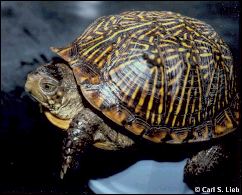
Many of us know that it's the man who genetically determines the sex of a child, and not surprisingly, we assume that's the case for everything. Alas, things aren't so simple in nature! Among birds, it's the female. But that's not the end of it. Some fish even change their sex according to their place in the social hierarchy or for other reasons. And let's consider turtles.
The Spiny Softshell Turtle, a freshwater, aquatic animal present in our Chihuahuan Desert waterways, is one of the few turtles to have its sex genetically determined. In most turtles, sex is set by the temperature at which the eggs are incubated. Even this is not simple. Three patterns are known among turtles: in one, higher temperatures result in a high frequency of females while in another, a high frequency of males. In the third pattern, high and low temperatures result in females and intermediate temperatures in males. In humans, sometimes we talk of a pregnant woman having one in the oven—somehow, this seems much more appropriate for turtles.

Contributor: Arthur H. Harris, Laboratory for Environmental Biology, Centennial Museum, University of Texas at El Paso.
Desert Diary is a joint production of the Centennial Museum and KTEP National Public Radio at the University of Texas at El Paso.

Western Box Turtle (Terrapene ornata). Photograph by Carl S. Lieb.
Charnov, E. L., and J. J. Bull. 1977. When is sex environmentally determined? Nature 266:828-830.
Ewert, M. A., and C. E. Nelson. 1991. Sex determination in turtles: Diverse patterns and some possible adaptive values. Copeia 1991:50-69.
Fox, H. 1977. The urinogenital system of reptiles. In Biology of the Reptilia (C. Gans, ed.). Volume 6. Academic Press, Inc., New York.
Gaffney, E. S. 1984. Historical analysis of theories of chelonian relationship. Syst. Zool. 33:283-301.
Graham, T. E. 1991. Life history notes: Apalone spinifera spinifera (Eastern Spiny Softshell). Pattern dimorphism. Herp. Rev. 22:97.
Mahmoud, I. Y., G. L. Hess, and J. Klicka. 1973. Normal embryonic stages of the western painted turtle, Chrysemys picta belli. J. Morph. 141:269-280.
Risley, P. L. 1933. Contributions on the development of the reproductive system in the musk turtle, Sternotherus odoralus (Latreille). II. Gonadogenesis and sex differentiation. Z. Zellforsch. 18:493-541.
Webb, G. J. W., D. Choquenot, and P. J. Whitehead. 1986. Nests, eggs and embryonic development of Carettochelys insculpta (Chelonia: Carettochelidae) from northern Australia. J. Zool., Lond. (B)1:521-550.
Webb, R. G. 1962. North American recent soft-shelled turtles (Family Trionychidae). Univ. Kan. Pub., Mus. Nat. Hist. 13:429-611.
Wibbels, T., J. J. Bull, and D. Crews. 1991. Chronology and morphology of temperature-dependent sex determination. J. Exper. Zool. 260:371-381.
Yntema, C. L. 1968. A series of stages in the embryonic development of Chelydra serpentina. J. Morph. 125:219-251.
Turtles and Global Climate Change.